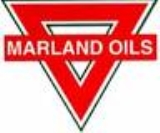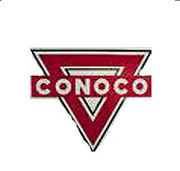
Marland Oil Company
Encyclopedia
Marland Oil Company was an American
oil company founded in 1917, by Ponca City, Oklahoma
oil exploration pioneer E. W. Marland
when he assembled his various holdings including the 101 Ranch Oil Company
into one unit, forming Marland Oil Company. Later, on January 3, 1921 Marland incorporated the Marland Oil Company in Delaware to acquire through an exchange of stock control of the Marland Refining Corp. and Kay County Gas Co.(1) By 1920 it is estimated that Marland and his partners controlled 10% of the worlds oil production (the equivalent of Saudi Arabia
By 1920 it is estimated that Marland and his partners controlled 10% of the worlds oil production (the equivalent of Saudi Arabia
in 2006) and that Marland was worth $85 million. (2)
By 1922 nearly 600 Marland stations were found in 11 mid-continent states, from North Dakota to Oklahoma and as far east as Indiana. Growth required capital, however, and Marland was continually strapped. Turning to investment banker J.P. Morgan and Company, Marland was able to secure financial backing for continued expansion, but with expansion came a hefty price. By 1928 Marland had been forced out by Morgan interests (Marland would later serve as Governor of and Congressman from Oklahoma.), who placed former Texaco executive Dan Moran in charge.
With orders from Morgan and Company to put Marland Oil back in the black, Moran set out to acquire key assets that would round out the Marland operation, allowing for increased financial stability. With this in mind, Marland management began to look around for a partner, a company with complementary assets, an operation that would perhaps consider a merger.
Talks began with Continental Oil along these lines in late 1928. In the meantime, Marland Oil had acquired Baltimore based Prudential Refining, since a refinery with East Coast marketing access would serve as a processing outlet for Marland's crude oil production. A merger with Continental would facilitate the Baltimore facility to supply Continental's existing Mid Atlantic marketing efforts, allowing for substantial growth in the number of retail service stations and the increased cash flow related to that increase in sales. On June 26, 1929 the merger was approved, and it acquired for a consideration of 2,317,266 shares of stock, the assets (subject to liabilities) of Continental Oil Company. (3) Although Marland Oil had been the "purchaser", management chose to retain the older and more accepted name, Continental Oil Company. The purchase combined all of the assets of the former Continental Oil, Marland Oil, Prudential Oil and other, lesser known production affiliates of the companies listed. Headquarters for the new company were to be Marland's old Ponca City, Oklahoma offices, with the former Conoco offices in Denver being retained as a district office. The new marketing logo would be a combination of the two previous logos, the Conoco name emblazoned on the crossbar of the famed Marland red triangle. It was an emblem that would remain in use, with minimal change, for the next 40-plus years.
United States
The United States of America is a federal constitutional republic comprising fifty states and a federal district...
oil company founded in 1917, by Ponca City, Oklahoma
Ponca City, Oklahoma
Ponca City is a small city in Kay and Osage counties in the U.S. state of Oklahoma, which was named after the Ponca Tribe. Located in north central Oklahoma, it lies approximately south of the Kansas border, and approximately east of Interstate 35. 25,919 people called Ponca City home at the...
oil exploration pioneer E. W. Marland
E. W. Marland
Ernest Whitworth Marland was an American lawyer, oil businessman, and politician who served as the tenth Governor of Oklahoma.-Career as an Oilman:...
when he assembled his various holdings including the 101 Ranch Oil Company
101 Ranch Oil Company
Founded in 1908 by oil exploration pioneer E. W. Marland, The 101 Ranch Oil Company was located on the famous Miller Brothers 101 Ranch and headquartered in Ponca City, Oklahoma...
into one unit, forming Marland Oil Company. Later, on January 3, 1921 Marland incorporated the Marland Oil Company in Delaware to acquire through an exchange of stock control of the Marland Refining Corp. and Kay County Gas Co.(1)

Saudi Arabia
The Kingdom of Saudi Arabia , commonly known in British English as Saudi Arabia and in Arabic as as-Sa‘ūdiyyah , is the largest state in Western Asia by land area, constituting the bulk of the Arabian Peninsula, and the second-largest in the Arab World...
in 2006) and that Marland was worth $85 million. (2)
By 1922 nearly 600 Marland stations were found in 11 mid-continent states, from North Dakota to Oklahoma and as far east as Indiana. Growth required capital, however, and Marland was continually strapped. Turning to investment banker J.P. Morgan and Company, Marland was able to secure financial backing for continued expansion, but with expansion came a hefty price. By 1928 Marland had been forced out by Morgan interests (Marland would later serve as Governor of and Congressman from Oklahoma.), who placed former Texaco executive Dan Moran in charge.
With orders from Morgan and Company to put Marland Oil back in the black, Moran set out to acquire key assets that would round out the Marland operation, allowing for increased financial stability. With this in mind, Marland management began to look around for a partner, a company with complementary assets, an operation that would perhaps consider a merger.
Talks began with Continental Oil along these lines in late 1928. In the meantime, Marland Oil had acquired Baltimore based Prudential Refining, since a refinery with East Coast marketing access would serve as a processing outlet for Marland's crude oil production. A merger with Continental would facilitate the Baltimore facility to supply Continental's existing Mid Atlantic marketing efforts, allowing for substantial growth in the number of retail service stations and the increased cash flow related to that increase in sales. On June 26, 1929 the merger was approved, and it acquired for a consideration of 2,317,266 shares of stock, the assets (subject to liabilities) of Continental Oil Company. (3) Although Marland Oil had been the "purchaser", management chose to retain the older and more accepted name, Continental Oil Company. The purchase combined all of the assets of the former Continental Oil, Marland Oil, Prudential Oil and other, lesser known production affiliates of the companies listed. Headquarters for the new company were to be Marland's old Ponca City, Oklahoma offices, with the former Conoco offices in Denver being retained as a district office. The new marketing logo would be a combination of the two previous logos, the Conoco name emblazoned on the crossbar of the famed Marland red triangle. It was an emblem that would remain in use, with minimal change, for the next 40-plus years.

Sources
- 1 Moody’s Industrial Manual, 1960
- 2 "E. W. Marland: Life and Death of an Oil Man", John Joseph Mathews. (Norman: University of Oklahoma Press, (1951): ISBN 0806112387
- 3 Moodys Industrial Manual, 1960.

